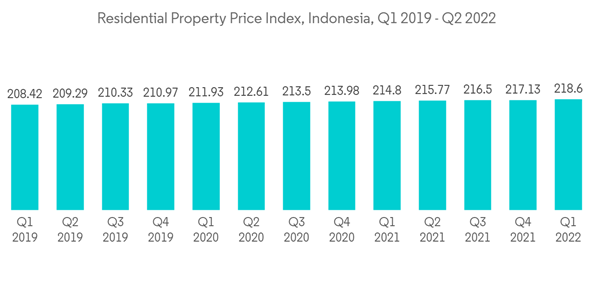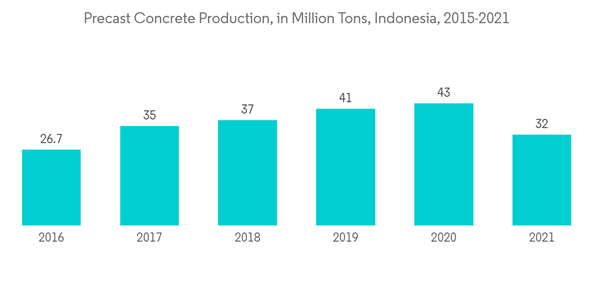The Indonesia Prefabricated Buildings Market size is estimated at USD 8.47 billion in 2024, and is expected to reach USD 11.38 billion by 2029, growing at a CAGR of 6.10% during the forecast period (2024-2029).
Prefab homes are less expensive to build. This type of construction can speed up construction by up to 50%, and with the right tradeoffs, it can cut costs by 20%. Many developers are using prefabricated construction to build residential projects to ultimately reduce the final pricing. This adoption of prefabricated construction may lead to increased sales of residential properties in the Indonesian market.
Precast concrete construction technology is one of the most promising solutions to deal with the rising demand for housing and infrastructure construction. As per data from the Indonesian Prefabricated and Prefab Company Association (AP3I), the production capacity of precast concrete is always increasing. In 2019, the national precast concrete production capacity was 41 million tons, which rose to 43 million tons in 2020. In 2021, the production declined to 32 million tons due to the second wave of COVID-19 and further lockdowns.
This product will be delivered within 2 business days.
Key Highlights
- The COVID-19 pandemic had a significant impact on the construction sector in Indonesia. Many projects were halted in 2020 due to a lack of funding, labor shortages, and lockdown laws. An exodus of migrant laborers, often known as informal sector employees, wreaked havoc on the supply chain due to travel prohibitions.
- However, due to the medical emergency during the peak of the pandemic in 2020, the demand for prefabricated hospitals and patient bed facilities soared, which boosted the demand for modular building systems, as these types of construction take much less time to complete.
- The demand for low-to-mid-rise residential buildings, project homes, and public housing mainly drives the market's growth.
- Prefabricated construction systems are becoming more popular than traditional ones due to their many advantages, including excellent quality, high strength, low weight, volume, and cost. Prefabricated building systems are frequently praised for their energy efficiency and eco-friendly construction.
- The growing commercial and residential sectors worldwide are driving the demand for ventilated thermal panels, which is the primary growth driver of the prefabricated buildings market.
Indonesia Prefabricated Buildings Market Trends
Rising Property Prices to Increase the Adoption of Prefab Construction
In terms of sales, the latest survey indicated stronger residential property sales in the primary market of Indonesia, accelerating to 15.23% (Y-o-Y) in the second quarter of 2022 after contracting 10.11% (Y-o-Y) in the first quarter of 2022. This trend indicates a growing demand for housing. However, the latest Residential Property Price Survey conducted by Bank Indonesia indicated that residential property prices posted modest annual gains in the second quarter of 2022, with the Residential Property Price Index (RPPI) growing by 1.72% (Y-o-Y), relatively limited compared to 1.77% (Y-o-Y) in the previous period. These increases in prices are discouraging property buyers.Prefab homes are less expensive to build. This type of construction can speed up construction by up to 50%, and with the right tradeoffs, it can cut costs by 20%. Many developers are using prefabricated construction to build residential projects to ultimately reduce the final pricing. This adoption of prefabricated construction may lead to increased sales of residential properties in the Indonesian market.
Precast Concrete Holds Largest Share in the Market
Precast concrete holds the largest share of the market, driven by the increase in off-site construction activity. The rapid infrastructure advancement initiated by the government of Indonesia has increased the demand for construction materials such as concrete, which is huge. Considering the benefits of precast concrete over cast-in-place concrete, increased adoption of precast concrete is to be seen in the construction sector. Increasing awareness among manufacturers, designers, constructors, and end clients of the benefits of utilizing precast concrete will further increase its adoption.Precast concrete construction technology is one of the most promising solutions to deal with the rising demand for housing and infrastructure construction. As per data from the Indonesian Prefabricated and Prefab Company Association (AP3I), the production capacity of precast concrete is always increasing. In 2019, the national precast concrete production capacity was 41 million tons, which rose to 43 million tons in 2020. In 2021, the production declined to 32 million tons due to the second wave of COVID-19 and further lockdowns.
Indonesia Prefabricated Buildings Industry Overview
The Indonesian prefabricated buildings market is fragmented in nature with the presence of several players in the market, with no player holding a significant market share. Kirby Building Systems, Laras Bali, Prefab World Bali International, PT Touchwood, and Teak Bali are some of the major players in the market.Additional Benefits:
- The market estimate (ME) sheet in Excel format
- 3 months of analyst support
This product will be delivered within 2 business days.
Table of Contents
1 INTRODUCTION1.1 Study Assumptions and Market Definition
1.2 Scope of the Study
2 RESEARCH METHODOLOGY
3 EXECUTIVE SUMMARY
4 MARKET INSIGHTS
4.1 Current Market Scenario
4.2 Technological Trends
4.3 Insights into Supply Chain/Value Chain Analysis of the Prefabricated Buildings Industry
4.4 Brief on Different Structures Used in the Prefabricated Buildings Industry
4.5 Cost Structure Analysis of the Prefabricated Buildings Industry
4.6 Impact of COVID-19 on the Market
5 MARKET DYNAMICS
5.1 Drivers
5.2 Restraints
5.3 Opportunitites
5.4 Porter's Five Forces Analysis
5.4.1 Bargaining Power of Suppliers
5.4.2 Bargaining Power of Consumers/Buyers
5.4.3 Threat of New Entrants
5.4.4 Threat of Substitute Products
5.4.5 Intensity of Competitive Rivalry
6 MARKET SEGMENTATION (Market Size be Value)
6.1 Material Type
6.1.1 Concrete
6.1.2 Glass
6.1.3 Metal
6.1.4 Timber
6.1.5 Other Material Types
6.2 Application
6.2.1 Residential
6.2.2 Commercial
6.2.3 Other Applications (Industrial, Institutional, and Infrastructure)
7 COMPETITIVE LANDSCAPE
7.1 Market Concentration Overview
7.2 Company Profiles
7.2.1 Bali Prefab
7.2.2 DTH Prefab
7.2.3 Karmod Prefabricated Technologies
7.2.4 Kirby Building Systems
7.2.5 Laras Bali
7.2.6 Prefab World Bali International
7.2.7 PT Touchwood
7.2.8 Sanwa Prefab Technology
7.2.9 Shandong Wiskind Architechtural Steel Co.
7.2.10 Teak Bali*
8 FUTURE OF THE MARKET
9 APPENDIX
9.1 Macroeconomic Indicators (GDP Breakdown by Sector, Contribution of Construction to Economy, etc.)
9.2 Key Production, Consumption, and Exports and Imports Statistics of Construction Materials
Companies Mentioned (Partial List)
A selection of companies mentioned in this report includes, but is not limited to:
- Bali Prefab
- DTH Prefab
- Karmod Prefabricated Technologies
- Kirby Building Systems
- Laras Bali
- Prefab World Bali International
- PT Touchwood
- Sanwa Prefab Technology
- Shandong Wiskind Architechtural Steel Co.
- Teak Bali*
Methodology

LOADING...










